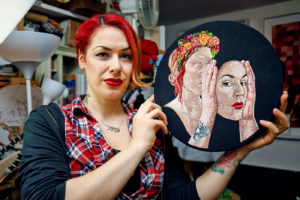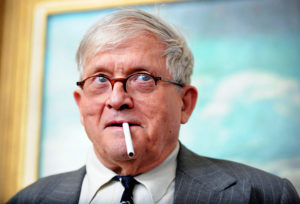Somewhere in a workshop in Tuscany, a robot is currently doing the work of the 5th-century BC sculptor, painter, and architect, Phidias. The 3D device is painstakingly recreating each carve, chisel, and curve of one of the sculptures of the Parthenon Marbles — the marbles that used to adorn the Temple of the Acropolis in Athens, before being removed to Britain by Lord Elgin between 1801 and 1812.
The robot is working at the behest of the Oxford-based research group, The Institute of Digital Archaeology — the team that, in 2016, created a 20-foot-tall replica of Syria’s Arch of Triumph, after it was destroyed by Isis terrorism in the ancient city of Palmyra. Last year, they took the reconstructive powers of technology one step further when they brought John Keats back to life, just in time for the bicentenary of his death. The necromancy was made complete by a reconstruction of Keats’s distinctive “cockney” voice — which you can hear in a CGI reading of his poem “Bright Star”.
However disconcerting this CGI-Keats might be, the Institute of Digital Archaeology’s most recent project has rather higher stakes. By copying the marbles, the Institute’s director, Roger Michel, hopes to create replicas which are “visually indistinguishable” from the sculptures and frieze housed in the British Museum. The team has even managed to source Pentelic marble — the same stone used by the Greeks back in the 5th century BC — to make these sculptures “exact duplicates”.
Michel’s intentions for these copies are not unambitious. After creating two prototypes, he wants to recreate the marbles Lord Elgin took from Greece in their entirety. These replicas will, in the Institute’s ideal world, replace the marbles in the British Museum so that the originals can be repatriated to the Acropolis Museum in Athens.
The idea has gained traction rapidly. The Times ran an editorial in favour of the swap, while The Guardian’s Simon Jenkins dismissed the views of “snooty art critics” who would damn the replicas as “fakes”. As for the Greeks, they have, understandably, latched onto it as a solution which could see the British Museum returning the marbles with as little fuss as possible.
But as with all things to do with the Parthenon Marbles, this is unlikely to be as simple as it might appear. Ignoring the fact that the British Museum’s position is still very much anti-repatriation — and, indeed, anti-reproduction: Michel had to resort to “guerrilla tactics” in order to scan the marbles for the 3D machining device, after the museum denied his request — there are difficulties in the nature of the replicas themselves: they could turn out to be better than those currently on display.
Back in 1938 — under the direction of the conman, forger, and art dealer Joseph Duveen — the marbles were scoured with metal tools and dipped in acid. The marble’s colour — a beige-brown patina, with traces of the original paint which had adorned them back in antiquity — was replaced by a blank, uniform white. But with the replicas, there is no need to replicate this extraordinary damage. If the swap went ahead, the British Museum’s replica marbles could be more intact than the ones they were responsible for damaging.
So why is the museum still so reluctant to consider repatriation? The most obvious answer is the inevitable political disagreement that will follow. But there’s something else at stake too. Beneath all the symbolism, op-eds, and campaigns, the Parthenon Marbles are works of art. And in the art world, copies, fakes, and replicas occupy a precariously odd position.
More than two and a half millennia after Phidias was carving the original Parthenon Marbles, and half a century before a robot would be making the copies, the American artist Sturtevant came up against this difficulty. Sturtevant — the professional name of the artist born Elaine Frances Horan — is now famed as the “mother of appropriation art” (an Eighties movement which prized using the work of others to create new, altered, art). But for more than a decade in the middle of her career, after facing a deluge of criticism, she was forced to retire from the art world.
Looking at Sturtevant’s work now, it is easy to understand why she may not have been a favourite in the art scene. Side by side, her version of Andy Warhol’s “Flowers” (imaginatively titled “Warhol’s Flowers”) is almost indistinguishable from the original. Her “repetitions” took the works of other Pop Art masters, and copied them with only the most subtle of changes.
Warhol, for what it’s worth, approved of her work — but other artists were not so accommodating. Upon seeing her version of his installation “The Store”, Claes Oldenburg never spoke to Sturtevant again. And after her 1973 show at Everson Museum of Art was met with the most lacklustre of responses, Sturtevant retired from the art world until the 1980s.
Here in Britain, a rather different figure inspired a similar debate. John Myatt is an artist and convicted forger, who spent four months in prison for his role in painting works which were sold as original artworks by painters ranging from Marc Chagall to Ben Nicholson. Myatt’s forgeries were so good that they were able to fool major auction houses including Christie’s and Sotheby’s; police estimates suggest that around 140 paintings are still in circulation. Now out of prison, Myatt continues to paint “genuine fakes” — and collectors can buy them as an affordable alternative to the real deal. Given they are visually indistinguishable from the originals, even to the most trained expert eyes, why are they valued so much less? The answer is something everyone knows instinctively: there is a romance, a delight, and an excitement to owning a piece of art by a famous painter that is not matched by a print or forgery, no matter how good it is.
Will the reproductions of the Parthenon Marbles face this problem? It could be argued that, rather than being forgeries in the John Myatt school, they are “repetitions” more akin to the work of Sturtevant. Myatt painted solely for financial gain, while both Sturtevant and the Parthenon project have conceptual, intellectual ramifications.
And what if these brilliantly accurate marbles are a different form of duplication entirely? They are not human forgeries, nor man-made experiments with the nature of repetition. The science of digital conservation and archaeology has gone beyond preservation — repairing damage; analysing paint-types and materials; and safeguarding against future harm — to also encompass creation. These works of art are, fundamentally, a work of technology, and they herald a brave new world for the possibilities of conservation and curation in museums.
Back in 2017, Gainsborough’s painting “The Morning Walk” was attacked by a screwdriver; in Amsterdam, Rembrandt’s “The Night Watch” has been knifed twice and sprayed with acid once. “The Mona Lisa” has suffered every indignity possible: rocks, teacups, cakes, and red paint have all been thrown on it. With the possibilities of digital reproduction, could we reach a point where beloved works of art are kept safely in vaults and only exact replicas sit on the walls of galleries?
There have already been entirely virtual exhibitions, including this Spring’s “Virtual Veronese” at the National Gallery. Visitors had the chance to see Paolo Veronese’s “The Consecration of Saint Nicholas” — an altarpiece in an Italian church — without ever leaving central London.
As technology improves, and the capacities of machines become ever more human, there is a chance that we begin to see more and more of these “perfect” reproductions of artworks — created long after the artist whose hand originally made them has died. This has already started to happen. Back in 2015, the Van Gogh Museum launched the “Relievo Collection”: exact replicas of the artist’s works (even complete with reproductions of the back of the canvases) for institutions and collectors to purchase. Walter Benjamin’s famous comments about the “aura” of art “wither[ing] in the age of mechanical production” seem all too prescient.
When I spoke to Michel, he argued that there is “a sharp distinction to be made between the marbles as art objects, and the marbles as beloved national treasures”. For him, this distinction is why the real marbles rather than the replicas should be returned to Greece. But as the science of preservation and conservation continues, perhaps we should also insist on a sharp distinction between works of art and marvels of technology. After all, it is the knowledge that a human hand carved the original Parthenon sculpture that makes them so emotive as both artworks and national treasures.
Yes, the opportunity to have these brilliant reproductions in their place is one not to be missed. But amid all these wonders of technology, let’s not forget that they’re not the real deal — any more than CGI Keats is the beloved poet brought back to life.
Disclaimer
Some of the posts we share are controversial and we do not necessarily agree with them in the whole extend. Sometimes we agree with the content or part of it but we do not agree with the narration or language. Nevertheless we find them somehow interesting, valuable and/or informative or we share them, because we strongly believe in freedom of speech, free press and journalism. We strongly encourage you to have a critical approach to all the content, do your own research and analysis to build your own opinion.
We would be glad to have your feedback.
Source: UnHerd Read the original article here: https://unherd.com/





